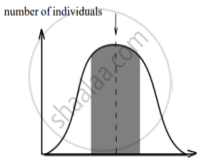Advertisements
Advertisements
प्रश्न
With the help of an algebraic equation, how did Hardy-Weinberg explain that in a given population the frequency of occurrence of alleles of a gene is supposed to remain the same through generations?
उत्तर १
Hardy-Weinberg principle states that the frequency of occurrence of alleles of a gene in a population remains constant through generations unless disturbances such as mutations, non-random mating etc. are introduced.
This principle can be understood with the help of the mathematical expression known as Hardy-Weinberg equation. Let us assume that a gene has two alleles in a population, A and a. If p is the frequency of occurrence of dominant allele A, and q is the frequency of occurrence of dominant allele a, the genotype frequency in the offsprings are represented as:
`(p + q)^2 =p^2 + 2pq + q^2 = 1`
where, the frequency of genotypes, AA is p2, that of aa is q2 and that of Aa is 2pq
Hence, the sum total of all allelic frequencies remains constant, i.e. 1
उत्तर २
In a given population one can find out the frequency of occurrence of alleles of a gene or a locus. This
frequency is supposed to remain fixed and even remain the same through generations. Hardy-Weinberg principle stated it using algebraic equations.
This principle says that allele frequencies in a population are stable and is constant from generation to generation. The gene pool (total genes and their alleles in a population) remains a constant. this is called genetic equilibrium. Sum total of all the allelic frequencies is 1. Individual frequencies, for example, can be named p, q, etc. In a diploid, p and q represent the frequency of allele A and allele a. The frequency of AA individuals in a
population is simply p2. This is simply stated in another way, i.e., the probability that an allele A with a frequency of p appears on both the chromosomes of a diploid individual is simply the product of the probabilities.
i.e `p^2`. Similarly of aa is q2, of Aa 2pq. Hence, `p^2 + 2pq + q^2 = 1`. This is a binomial expansion of (p + q)2. When frequency measured, differs from expected values, the difference (direction) indicates the extent of evolutionary change. Disturbance in genetic equilibrium, or Hardy-Weinberg equilibrium, i.e., change of frequency of alleles in a population would then be interpreted as resulting in evolution.
APPEARS IN
संबंधित प्रश्न
Differentiate between Directional natural selection and Disruptive natural selection.
How does the Hardy-Wienberg equation explain genetic equilibrium?
A population will not exist in Hardly Weiberg equilibrium if ____________.
Disturbance of Hardy - Weinberg equilibrium results in
For the MN-blood group system, the frequencies of M and N alleles are 0.7 and 0.3, respectively. The expected frequency of MN-blood group bearing organisms is likely to be ______.
State and explain any three factors affecting allele frequency in populations.
Enumerate three most characteristic criteria for designating a Mendelian population.
The graphs below show three types of natural selection. The shaded areas marked with arrows show the individuals in the population who are not selected. The dotted vertical lines show the statistical means.
 |
 |
 |
| character Graph A |
character Graph B |
character Graph C |
- What names are given to the types of selection shown in graphs A, B and C?
- After the selection has operated for several generations in the above populations indicated as, Graph A, B and C, graphically illustrate the probable results.
Explain Hardy-Weinberg's principle
A population of 200 fruit flies is in Hardy Weinberg equilibrium. The frequency of the allele (a) 0.4. Calculate the following:
The number of homozygous recessive fruit flies.
